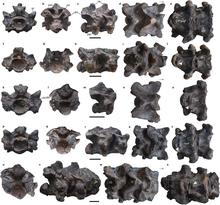Vasuki indicus
| Vasuki Temporal range: Middle Eocene (Lutetian), ~
| |
|---|---|

| |
| Select holotype vertebrae of Vasuki | |
| Scientific classification | |
| Domain: | Eukaryota |
| Kingdom: | Animalia |
| Phylum: | Chordata |
| Class: | Reptilia |
| Order: | Squamata |
| Family: | †Madtsoiidae |
| Genus: | †Vasuki |
| Species: | †V. indicus
|
| Binomial name | |
| †Vasuki indicus | |
Vasuki is an extinct genus of madtsoiid snake from the Middle Eocene Naredi Formation of India. The genus contains a single species, V. indicus, known from several vertebrae. Vasuki has an estimated body length between 10.9–15.2 m (36–50 ft), making it the largest known madtsoiid. The upper bounds of the length estimates would make Vasuki the longest snake ever discovered.
Discovery and naming
[edit]
The holotype specimen of Vasuki, IITR/VPL/SB 3102-1-21, was discovered in 2005 within the sedimentary layers of the Naredi Formation in the Panadhro Lignite Mine in the Kutch district of Gujarat State, western India.[1] The specimen consists of 27 pre-cloacal vertebrae, some of which were found in articulation.[2] The fossil material was found some time after 2004, and preliminary analyses suggested crocodilian affinities for the fossil material without further review.[3]
In 2024, Vasuki indicus was described as a new genus and species of madtsoiid snake based on these fossil remains. The generic name, Vasuki, references the divine serpent of the same name from Hindu mythology. The specific name, indicus, references India, the country where the Vasuki fossils were found.[2]
Description
[edit]
The body length estimations of Vasuki are derived from predictive regression equations:[2] one based on postzygapophyseal width,[4] and the other based on prezygapophyseal width.[5] The former equation resulted in a body length range of 10.9–12.2 metres (36–40 feet), while the latter equation resulted in a body length range of 14.5–15.2 metres (48–50 feet).[2] Although the vertebral dimensions of Vasuki are smaller than those of Titanoboa (estimated at 12.8 m (42 ft) ± 2.2 m (7 ft 3 in)), the largest length estimates indicate a longer body for Vasuki.[2][6]
Classification
[edit]
In a phylogenetic analyses, Vasuki is recovered as a member of the extinct snake clade Madtsoiidae as the sister taxon to the clade formed by Madtsoia pisdurensis (Late Cretaceous India) and Gigantophis garstini (Late Eocene North Africa). It is a member of a lineage of medium–large bodied madtsoiids, which is in turn the sister taxon to a clade of smaller madtsoiids. The results are displayed in the cladogram below:[2]
| Madtsoiidae |
| ||||||||||||||||||||||||||||||||||||||||||||||||||||||||||||||||||||||||||||||||||||||||||
Paleoenvironment
[edit]Unlike other large-bodied snakes like Titanoboa,[4] Vasuki was probably not an aquatic animal. Its vertebral morphology instead suggests a terrestrial (or possibly semi-aquatic) lifestyle when compared to related madtsoiids and modern pythonoids. The Vasuki fossils were deposited in a backswamp marsh. Large extant pythonids are found in similar habitats.[2]
Vasuki is known from the Naredi Formation, which dates to the Middle Eocene.[2] Fossils of catfish, turtles, crocodilians, and early cetaceans, like Andrewsiphius and Kutchicetus,[7][8] are also known from this formation, any of which may have been the prey of Vasuki.[9] At this time, India was largely isolated from Asia.
See also
[edit]References
[edit]- ^ Hunt, Katie (19 April 2024). "Colossal prehistoric snake discovered in India". edition.cnn.com. Retrieved 28 July 2024.
- ^ a b c d e f g h Datta, Debajit; Bajpai, Sunil (18 April 2024). "Largest known madtsoiid snake from warm Eocene period of India suggests intercontinental Gondwana dispersal". Scientific Reports. 14 (1): 8054. doi:10.1038/s41598-024-58377-0. ISSN 2045-2322. PMC 11549349. PMID 38637509.
- ^ Williams, Riis (18 April 2024). "This Nearly 50-Foot Snake Was One of the Largest to Slither the Earth". Scientific American. Retrieved 19 April 2024.
- ^ a b Head, J.J.; Bloch, J.I.; Hastings, A.K.; Bourque, J.R.; Cadena, E.A.; Herrera, F.A.; Polly, P.D.; Jaramillo, C.A. (2009). "Giant boid snake from the Paleocene neotropics reveals hotter past equatorial temperatures". Nature. 457 (7230): 715–717. Bibcode:2009Natur.457..715H. doi:10.1038/nature07671. PMID 19194448. S2CID 4381423.
- ^ McCartney, Jacob; Roberts, Eric; Tapanila, Leif; O'Leary, Maureen (2018). "Large palaeophiid and nigerophiid snakes from Paleogene Trans-Saharan Seaway deposits of Mali". Acta Palaeontologica Polonica. 63. doi:10.4202/app.00442.2017. ISSN 0567-7920. S2CID 59147071.
- ^ Head, J.J.; Bloch, J.I.; Hastings, A.K.; Bourque, J.R.; Cadena, E.A.; Herrera, F.A.; Polly, P.D.; Jaramillo, C.A. (2009). "Giant boid snake from the Paleocene neotropics reveals hotter past equatorial temperatures". Nature. 457 (7230): 715–717. Bibcode:2009Natur.457..715H. doi:10.1038/nature07671. PMID 19194448. S2CID 4381423.
- ^ Dunham, Will (18 April 2024). "Fossils of colossal snake Vasuki unearthed in India mine". Reuters.
- ^ Sharma, Apoorna (19 April 2024). "Fossil of largest-ever snake 'Vasuki' unearthed in western India mine". Wion. Retrieved 30 December 2024.
- ^ Larson, Christina (18 April 2024). "This ancient snake in India might have been longer than a school bus and weighed a ton". AP News. Retrieved 19 April 2024.
